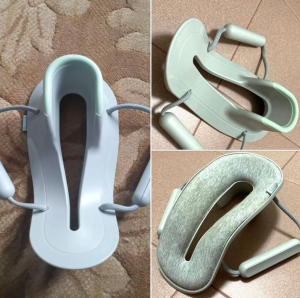At first glance, the object in the photo might spark a few puzzled expressions — and rightly so. With its sleek, U-shaped design, soft materials, pull cords, and a slightly ambiguous form, it leaves room for plenty of wild guesses. Is it a tech gadget? A home gym tool? A futuristic helmet for dogs?
But the answer is surprisingly simple:
This is a sock aid device.
Yes, a mobility aid tool — specifically designed to help individuals with limited flexibility or mobility put on their socks more easily and independently.
Let’s dive into a full breakdown: what it is, how it works, who uses it, and why it’s such a life-changer for many.
🔎 What Is This Object?
The device pictured is called a sock aid or sock donner. It’s a form of adaptive equipment that helps people pull socks onto their feet without having to bend over.
It consists of:
-
A flexible or semi-rigid plastic shell (U- or funnel-shaped),
-
Pull cords or handles attached to the sides,
-
Often a soft inner lining or fabric cover for friction and comfort.
The wide slot and open center allow a sock to be stretched over it. Once the sock is in place, the user inserts their foot into the opening, then pulls the device upward using the cords — sliding the sock perfectly onto their foot.
🦶 How It Works – Step-by-Step
-
Slip the sock over the device
The user stretches the sock over the soft opening of the sock aid, heel-side down, with the toe of the sock pointing forward and snug over the tip of the device. -
Drop the device to the floor
Using the handles or cords, they lower the device to the ground without needing to bend over. -
Insert foot into the opening
The foot is guided into the mouth of the sock aid — which holds the sock open and ready. -
Pull the handles
As they pull the cords, the sock aid slides up the leg, smoothly drawing the sock onto the foot and up the ankle or calf. -
Remove the device
Once the sock is on, the sock aid pulls out from the top, leaving the user fully socked without ever touching their foot.
It’s incredibly effective — and elegantly simple.
🧓 Who Uses Sock Aids?
Sock aids are used by people of all ages but are most commonly helpful for:
-
Seniors or the elderly with reduced flexibility or arthritis
-
Post-surgery patients (especially hip or back surgery)
-
People with mobility impairments or disabilities
-
Individuals recovering from injuries
-
Pregnant women who find it hard to bend over
-
People with chronic pain or conditions like Parkinson’s disease or multiple sclerosis
They are often recommended by physical therapists, occupational therapists, and rehabilitation doctors to promote independence in daily dressing tasks.
🛏️ Why It Matters: Independence & Dignity
Tasks like putting on socks might seem small — even trivial — until you can’t do them.
For someone who struggles to bend, reach their feet, or balance on one leg, putting on a pair of socks becomes a frustrating, even impossible task. Needing daily assistance with such a basic routine can impact confidence, mood, and quality of life.
Sock aids give people their freedom back. It lets them:
-
Get dressed without help
-
Maintain dignity and privacy
-
Preserve independence, especially during recovery or aging
It’s a simple tool — but often a powerful one.
🛍️ Design Variations & Comfort Features
The device in the image appears to be a modern, ergonomic sock aid — thoughtfully designed with:
-
Soft, padded edges to avoid digging into the skin
-
Comfort grip handles with cords for pulling
-
A felt-like lining on the inner shell, likely for friction, so the sock doesn’t slip off prematurely
-
A smooth contour for comfortable foot insertion
Not all sock aids look this modern. Some older designs are plain plastic or even rigid metal with minimal padding. The one shown here is definitely in the “premium” range.
🧠 The Psychology of Accessibility Devices
It’s worth noting that tools like these are often underappreciated — or worse, stigmatized. Many people resist using mobility aids because of pride, embarrassment, or a belief they’re “giving in” to age or weakness.
But the truth is, using the right tools can extend independence, prevent injury, and improve well-being. Devices like the sock aid empower people to keep doing things for themselves. And that’s a victory — not a defeat.
💬 Common Misinterpretations
Because of its shape, the device in the photo often draws humorous or confused guesses from people seeing it for the first time. Some of the most popular guesses include:
-
A baby seat insert
-
A portable urinal
-
A VR headset holder
-
A toilet training tool
-
A pet restraint or feeding harness
But once you see it in action — it all makes sense.
✅ Final Thoughts
The object in your photo may not look flashy, but it represents something deeply valuable: human dignity and design that meets people where they are.
In a world that often celebrates high-tech gadgets, this low-tech tool stands out as something powerful — not because of complexity, but because of its impact. It’s a quiet revolution in independence for the elderly, disabled, and injured.
So next time you see something strange and U-shaped with ropes and soft padding, you’ll know — it’s not a mystery. It’s a lifeline in plastic and fabric, making someone’s morning easier, gentler, and more independent.
